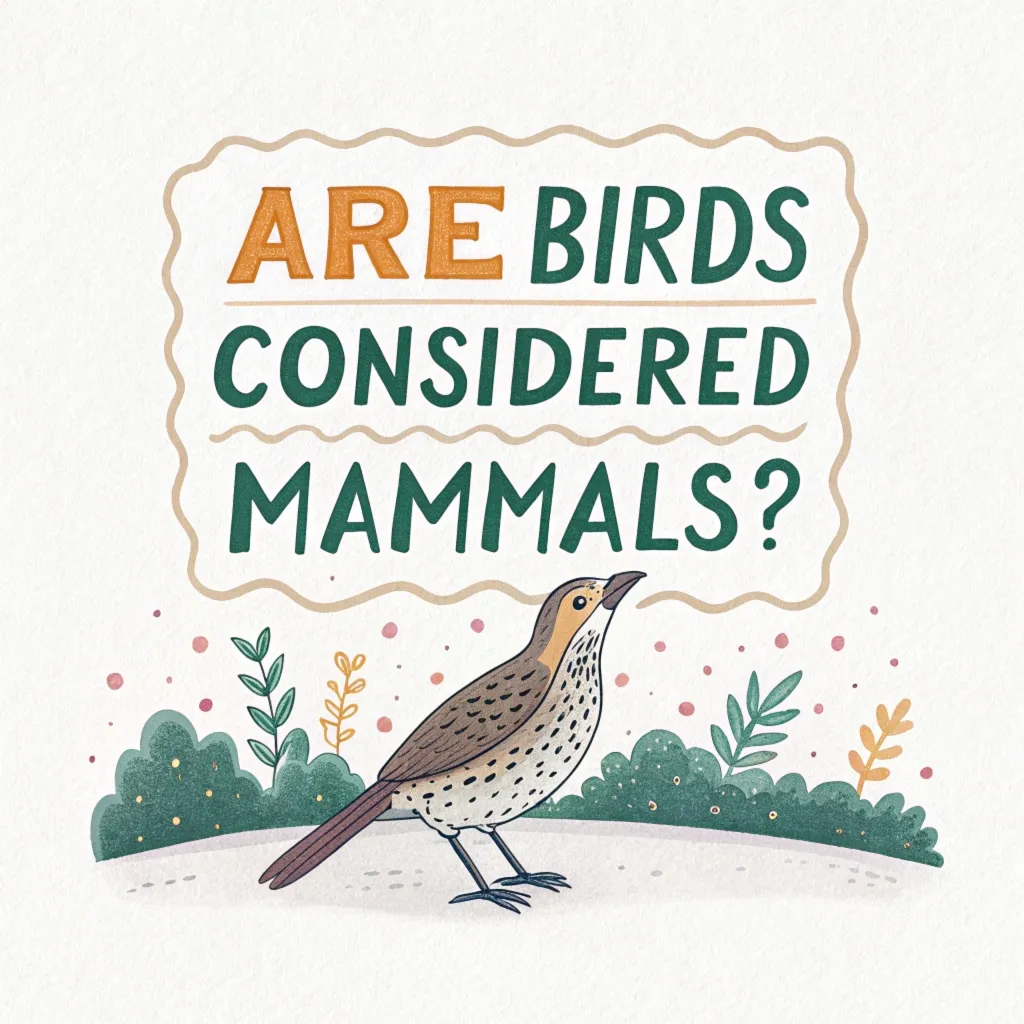Are Birds Considered Mammals? Understanding Avian Classification
Birds captivate people with their ability to fly and their diverse appearances. Many wonder about their place in the animal kingdom. This article explores bird classification and answers a common question: Are birds mammals?
Birds and mammals share some traits. Both are warm-blooded vertebrates. They care for their young. However, birds have unique features that set them apart. These include feathers, beaks, and the ability to lay eggs.
This exploration will cover bird anatomy, behavior, and their role in ecosystems. We’ll also address common misconceptions about bird classification.

Key Takeaways: Birds vs. Mammals
- Birds are not mammals but belong to the class Aves
- Birds have unique features like feathers and hollow bones
- Mammals give birth to live young, while birds lay eggs
- Birds have a specialized respiratory system for flight
- Both birds and mammals are warm-blooded vertebrates
- Birds have a beak instead of teeth
- Mammals have mammary glands to produce milk for their young
- Birds have a higher metabolic rate than most mammals
- The closest living relatives of birds are crocodiles
- Birds evolved from a group of dinosaurs called theropods
The distinction between birds and mammals is a fundamental aspect of zoology and evolutionary biology.
Understanding these differences not only helps us appreciate the diverse adaptations of different animal groups but also provides insights into the complex evolutionary processes that have shaped life on Earth.
As we explore the unique characteristics of birds, we’ll gain a deeper appreciation for their remarkable abilities and their place in the animal kingdom.
Understanding Animal Classification
Animal classification is a systematic way of organizing living organisms based on their shared characteristics.
The system we use today was developed by Carl Linnaeus and has undergone modifications as our understanding of evolution and genetics has improved. In this system, animals are grouped into increasingly specific categories.
The main levels of classification are:
- Kingdom
- Phylum
- Class
- Order
- Family
- Genus
- Species
Birds belong to the kingdom Animalia, phylum Chordata, and class Aves. This places them in a different class from mammals, which belong to the class Mammalia.
The science of classification, known as taxonomy, is an ever-evolving field. As new discoveries are made and genetic analysis techniques improve, our understanding of the relationships between different animal groups continues to refine and expand.
This ongoing process highlights the importance of scientific research in shaping our knowledge of the natural world and the interconnectedness of all living things.
Defining Characteristics of Birds

Birds are warm-blooded vertebrates characterized by several unique features:
- Feathers: All birds have feathers, which are used for flight, insulation, and display.
- Beaks: Birds have beaks instead of teeth.
- Hollow bones: Most birds have hollow bones to reduce weight for flight.
- Egg-laying: Birds lay hard-shelled eggs.
- High metabolic rate: Birds have a higher metabolism than most other animals.
- Four-chambered heart: Like mammals, birds have a four-chambered heart.
These features set birds apart from other animal groups and contribute to their unique adaptations for flight and survival in various environments.
The remarkable adaptations of birds have allowed them to thrive in a wide range of habitats across the globe. From the frigid Antarctic to the scorching deserts, birds have evolved specialized features to cope with extreme conditions.
Their ability to fly has given them a significant advantage in terms of mobility and resource exploitation, making them one of the most successful vertebrate groups on Earth.
Mammalian Traits: Why Birds Don’t Qualify
Mammals have several distinctive characteristics that birds do not possess:
- Hair or fur: All mammals have some form of hair or fur at some point in their lives.
- Mammary glands: Mammals produce milk to feed their young.
- Live birth: Most mammals give birth to live young (with some exceptions like monotremes).
- Three middle ear bones: Mammals have three bones in their middle ear for hearing.
- Neocortex: Mammals have a more complex brain structure.
Birds lack these mammalian traits, which is why they are classified separately from mammals.
The evolutionary paths of birds and mammals diverged millions of years ago, leading to the development of these distinct characteristics.
While both groups have achieved remarkable success in their respective niches, their physiological differences reflect the diverse solutions that evolution has produced to address the challenges of survival and reproduction.
Understanding these differences helps us appreciate the incredible diversity of life on our planet.
The Avian Respiratory System
Birds have a unique respiratory system that is highly efficient and adapted for flight. Unlike mammals, which have a bidirectional breathing system, birds have a unidirectional airflow through their lungs. This system includes:
- Air sacs that extend into bones
- A constant flow of fresh air through the lungs
- More efficient oxygen extraction
This respiratory system allows birds to maintain high energy levels during flight and at high altitudes.
The avian respiratory system is a marvel of evolutionary engineering. It enables birds to extract oxygen from the air with remarkable efficiency, supporting their high-energy lifestyle and allowing them to fly at altitudes where the air is thin.
This adaptation is crucial for migratory species that undertake long-distance flights, often crossing vast oceans or mountain ranges.
The integration of air sacs into their skeletal structure also contributes to the lightweight yet strong body design that is essential for flight.
Bird Reproduction: Eggs vs. Live Birth

One of the most obvious differences between birds and mammals is their reproductive strategy. Birds lay eggs, while most mammals give birth to live young. The egg-laying process in birds involves:
- Production of a hard-shelled egg
- External incubation
- Hatching of fully developed chicks
This reproductive method allows birds to be more mobile and adaptable to various environments.
The egg-laying strategy of birds offers several advantages. It allows female birds to deposit their offspring in safe locations and then move on, which can be particularly beneficial for migratory species.
The hard shell of bird eggs provides protection against environmental hazards and predators. Additionally, the process of incubation allows for parental care without the need for internal gestation, which would significantly increase the weight of flying birds.
This reproductive approach has been a key factor in the successful colonization of diverse habitats by birds across the globe.
Feathers: A Unique Avian Feature
Feathers are perhaps the most distinctive feature of birds. They serve multiple purposes:
- Flight
- Insulation
- Waterproofing
- Display and communication
No other animal group possesses feathers, making them a key identifier for the avian class.
The evolution of feathers is a fascinating chapter in the story of bird development. Originally thought to have evolved solely for flight, we now know that feathers likely first appeared for insulation and display purposes.
The complex structure of feathers, with their interlocking barbules, provides an incredibly lightweight yet strong surface for flight. Beyond their functional roles, feathers also play a crucial part in bird behavior and ecology.
The vibrant colors and intricate patterns of many bird species are used for camouflage, mate attraction, and species recognition, showcasing the multifaceted nature of this unique avian adaptation.
The Evolution of Birds from Dinosaurs
Birds are the living descendants of a group of dinosaurs called theropods. This evolutionary link has been established through:
- Fossil evidence
- Shared anatomical features
- Genetic studies
Understanding this evolutionary history helps explain why birds have some reptile-like characteristics while also being warm-blooded like mammals.
The discovery of feathered dinosaur fossils in recent decades has revolutionized our understanding of bird evolution. These findings have provided a clear evolutionary pathway from small, feathered theropod dinosaurs to the diverse array of bird species we see today.
This transition involved numerous adaptations, including the development of powered flight, the evolution of a beak, and changes in metabolic rate.
The study of bird evolution continues to be an active area of research, with new fossil discoveries and genetic analyses constantly refining our knowledge of how these remarkable creatures came to be.
Avian Intelligence and Behavior
Despite not being mammals, birds exhibit remarkable intelligence and complex behaviors:
- Tool use in some species
- Problem-solving abilities
- Social learning
- Complex vocalizations and communication
These cognitive abilities demonstrate that advanced intelligence is not limited to mammals in the animal kingdom.
The cognitive capabilities of birds have been a subject of increasing scientific interest in recent years. Studies have shown that some bird species, particularly corvids (crows, ravens, and magpies) and parrots, display levels of intelligence comparable to great apes.
These birds can solve complex puzzles, use tools, and even recognize themselves in mirrors, a trait once thought to be unique to humans and a few other mammal species.
The social intelligence of many bird species is also noteworthy, with some forming complex social hierarchies and engaging in cooperative behaviors. These findings challenge our traditional views on animal intelligence and highlight the diverse evolutionary paths that can lead to cognitive sophistication.
Birds and Mammals: Shared Traits
While birds and mammals are distinct groups, they do share some important characteristics:
- Warm-blooded metabolism
- Four-chambered heart
- Care for their young
- Highly developed senses
These shared traits are examples of convergent evolution, where different groups evolve similar features independently.
The similarities between birds and mammals provide fascinating insights into evolutionary processes. Both groups independently evolved endothermy (warm-bloodedness), which allows for sustained high-energy activities and the ability to thrive in a wide range of environments.
The development of parental care in both birds and mammals has led to complex social behaviors and the ability to pass learned behaviors from one generation to the next.
These shared traits highlight how similar environmental pressures can lead to the evolution of comparable adaptations in distantly related groups, demonstrating the power of natural selection in shaping life on Earth.
The Diversity of Bird Species
The class Aves includes an incredible diversity of species, with over 11,000 living species identified. This diversity spans:
- Size (from tiny hummingbirds to large ostriches)
- Habitat (from deserts to polar regions)
- Diet (from nectar-feeding to predatory birds)
- Behavior (from solitary to highly social species)
This wide range of adaptations showcases the success of the avian body plan in various ecological niches.
The remarkable diversity of bird species is a testament to their evolutionary success. Birds have adapted to virtually every terrestrial habitat on Earth, from the driest deserts to the wettest rainforests, and even to life on the open ocean.
This adaptability is reflected in their varied diets, with species evolving to feed on everything from tiny insects to large mammals.
The range of bird behaviors is equally impressive, with some species forming complex social societies while others lead solitary lives.
This diversity not only makes birds a fascinating subject of study but also highlights their critical roles in ecosystems worldwide, from seed dispersal to pest control.
Conservation and the Importance of Birds
Birds play crucial roles in ecosystems worldwide and are important indicators of environmental health. Conservation efforts for birds are essential because:
- They help control insect populations
- They contribute to seed dispersal and pollination
- Many species are keystone species in their ecosystems
- Birds are important for ecotourism and birdwatching industries
Protecting bird species and their habitats is vital for maintaining biodiversity and ecological balance.
The conservation of bird species is not just about preserving beautiful and interesting creatures; it’s about maintaining the health of entire ecosystems.
Birds are often referred to as “indicator species” because their presence, absence, or population changes can signal broader environmental issues.
For example, the decline of certain bird species can indicate habitat loss, pollution, or climate change impacts. Additionally, the economic value of birds should not be underestimated.
Birdwatching and avian ecotourism contribute billions of dollars to the global economy annually. By protecting birds and their habitats, we are investing in the health of our planet and the well-being of human communities that depend on stable, functioning ecosystems.
FAQs About Bird Classification
Are penguins considered mammals?
No, penguins are not mammals. They are birds belonging to the order Sphenisciformes. Despite being flightless and adapted for swimming, penguins have all the characteristic features of birds, including feathers, beaks, and the ability to lay eggs.
Do any mammals lay eggs?
Yes, a small group of mammals called monotremes lay eggs. This group includes the platypus and echidnas. However, these are rare exceptions in the mammalian class, and they still possess other mammalian characteristics like producing milk for their young.
Can birds be warm-blooded if they’re not mammals?
Yes, birds are warm-blooded (endothermic) like mammals. This means they can regulate their body temperature internally, independent of the external environment. This trait is crucial for their high-energy lifestyle and ability to fly.
How are birds different from reptiles?
While birds evolved from reptilian ancestors, they have several distinct features that set them apart:
- Warm-blooded metabolism
- Feathers instead of scales (although some birds retain scales on their legs)
- More efficient respiratory and circulatory systems
- Generally higher intelligence and more complex behaviors
Are there any mammals that can fly?
Bats are the only mammals capable of true powered flight. However, some other mammals like flying squirrels can glide through the air for short distances. Bats achieve flight through a different mechanism than birds, using membranous wings instead of feathered ones.

Joyce is the passionate founder of Chirping Hearts, a website dedicated to sharing her love for birds and providing valuable information about avian life. With a background in ornithology and years of experience in birdwatching, Joyce aims to inspire others to appreciate the beauty and diversity of birds. Through her engaging articles and guides, she hopes to foster a community of bird enthusiasts who share her enthusiasm for these incredible creatures. When she’s not writing, Joyce enjoys exploring nature trails and observing birds in their natural habitats.







